The Easiest Way to Make Zippered Pillow Covers
Any home decor lover knows the power of throw pillows to transform a living space from ordinary to fabulous. Let’s face it, custom-made pillows – ones that are made just for your space – can be very expensive. Let me show you the easiest way to make zippered pillow covers that you will be proud to have in your home.
Accent pillows are one of our favorite ways to add style, color, pattern and texture to any room. They add a dash of charm and comfort to our living spaces. The sense of detail that accent pillows provide can’t be beat.
The best part? You don’t have to be a sewing expert to master this craft. With a pinch of creativity and a few basic sewing skills, you’ll be amazed at the professional-looking results you can achieve.
Plus, crafting your own pillow covers not only allows you to customize your home decor but also lets you save a pretty penny compared to store-bought options.
Welcome to this month’s Creative Craft Blog Hop, hosted by Donna of Modern on Monticello. I love to see the projects my friends have created. I know you do too.
Why You Should Make Zippered Pillows
Retail pillows that have zippers are more expensive than ones that don’t. For good reason: there is more labor involved and additional supplies.
The additional cost is well worth it. Zippered pillows naturally have a more expensive look and feel to them.
Most home decor lovers know that changing out pillows for the seasons and holidays gives our homes more interest throughout the year. It’s so easy to give our homes a fresh look with new pillows.
Here are the reasons we love zippered pillows:
- Using zippered pillow covers means you can change out pillows more frequently for different seasons.
- You don’t have to worry about where to store all the extra pillows when they are not in use. Storing just pillow covers takes a fraction of the space of an entire pillow.
- Reusing pillow inserts allows you to spend your home decor budget on higher quality pillow inserts, like down.
- Most accent pillows will be 18 or 20 inches. If you have four of each size, that should cover most of your pillow decor needs.
- Purchasing only pillow covers allows you to focus on beautiful fabrics with colors, patterns, and textures that truly enhance the beauty of your home.
EXCEPT – decorative designer pillows from the home decor stores can cost up to $200 – $300. Yikes. That can break any home decor budget. Having pillows custom-made for you is even more expensive.
Yes, you can find nice throw pillows for less if you are not too picky about the quality of the fabric or the workmanship. I have certainly purchased pillows in the lower price ranges that served me well.
BUT – when you want pillows that are designed just for your space, ones that match your color scheme and design aesthetic, nothing beats a DIY custom-made pillow.
That’s why I want to share this pillow tutorial and show you the easiest way to make zippered pillow covers that you will love.
Yes, you do have to use a sewing machine. You don’t need any fancy attachments to be an expert seamstress. In fact, sewing a DIY pillow cover is one of the easiest sewing projects. A total beginner can do it.
If you can sew a straight line, you can make a DIY throw pillow.
I hope that this easy tutorial will be the beginning of your love affair with making your own custom pillows. If this is your first pillow cover, then welcome to the wonderful world of simple sewing projects.
Choosing Your Fabric
For me, making a pillow cover begins with the fabric. Your need for a standard pillow cover immediately is followed by a search for the perfect fabric.
The fabric you choose can influence the look, feel, and longevity of your throw pillows. Take a moment to envision the style you want to achieve. Let your chosen fabric bring that vision to life in the coziest and most stylish way possible.
When it comes to crafting the perfect throw pillows, the choice of fabric can make all the difference in both style and comfort. Here’s a list of some of the best fabrics to consider for your zippered pillow covers:
- Cotton: A timeless favorite, cotton fabrics come in a variety of patterns and colors. They’re durable, breathable, and easy to work with, making them an excellent choice for beginners and experienced crafters.
- Linen: If you’re after a relaxed, natural vibe, linen is your go-to option. Its textured appearance adds a touch of sophistication to your pillows while maintaining a casual charm.
- Velvet: For a touch of luxury and opulence, velvet is a fabulous pick. Its soft, plush texture adds depth to your decor and can create an elegant focal point in any room.
- Canvas: If you’re seeking a sturdy and versatile fabric, canvas fits the bill. With its durability and weight, it’s perfect for creating pillows with a casual look that can withstand everyday use.
- Silk: For a dash of elegance and sheen, silk brings a sense of refinement to your throw pillows. Just remember that it’s a bit more delicate, so it’s best suited for pillows that won’t see heavy traffic.
- Outdoor Fabrics: If you’re planning to place your pillows in high-traffic areas or outdoor spaces, consider using outdoor fabrics. They’re designed to resist fading and weather damage, ensuring your pillows stay vibrant and look their best.
- Prints and Patterns: Don’t shy away from experimenting with prints and patterns. Floral, geometric, or abstract designs can add a pop of personality and intrigue to your pillows, enhancing the overall aesthetic of your space.
Most cities have multiple fabric stores, both for making clothes and home decor items. Most places will give swatches to take home to consider or coordinate with existing fabrics.
Sometimes you may have to special order a particular fabric, but it’s worth waiting for the right fabric.
TIP: Do check that the fabrics are well-made and that the patterns are correctly aligned.
The great thing about buying fabric for pillows is that you normally don’t have to worry about repeats or aligning patterns. And it doesn’t take much fabric to make beautiful pillows.
I have found that the staff at fabric stores are very knowledgeable and will help you determine the right amount of fabric for your pillow projects.
TIP: Always round-up when buying yardage. You don’t want to be short.
Why A Sewing Machine is Best for Making Zippered Pillows
Although I have made no-sew pillows for fun and seasonal crafts, nothing beats a sewing machine for producing the best and most long-lasting pillows.
Opting to use a sewing machine for crafting your zippered throw pillows is the best option. Why?
- Sewing machines offer precise stitching, making it easier to maintain even seams and consistent stitches throughout your project.
- A sewing machine is particularly beneficial for sewing straight lines for zipper installation and seam closures, ensuring a professional finish that adds to the overall polished look of your pillows.
- Sewing machines are designed to handle a variety of fabrics, from delicate silk to sturdy canvas, making them versatile tools for any pillow-making endeavor.
- A sewing machine speeds up the process and allows you to attempt more intricate projects, such as piping, decorative trims, or appliques.
Whether you’re a sewing novice or a seasoned pro, utilizing a sewing machine can significantly enhance the quality and efficiency of your DIY pillow-making project.
My sewing machine is a Sears Kenmore that I have had for over 15 years. It’s my second Kenmore. My dad bought me my first sewing machine when I was in college (from my boyfriend’s sister). It lasted me for years until the motor gave out.
I have made clothes (for myself and my kids and grandkids), curtains, drapes, duvets, valances, comforters, and, of course, pillows. Even a basic sewing machine will pay for itself many times over.
A throw pillow is one of the easiest sewing projects you can make. It only uses a straight stitch and it doesn’t require a pattern.
If you have wanted to try your hand at sewing, then zippered throw pillow covers should be your first project. You’ll love the results and be proud of your first sewing attempt.
Supplies for Your Zippered Pillow Cover
The great thing about making pillow covers is that they require straight measures, straight cutting, and straight sewing. I have found that these supplies make measuring, cutting, and ironing fabric projects simple and efficient.
- a cutting mat – the 24 – 36-inch size is perfect for sewing projects. I messed this one up by using my ironing mat and ironing over it. It warped and buckled. Right after I began this project, I replaced it with a new one.

- rotary cutter – the best way to cut long straight lines on fabric. You get a cleaner cut than scissors and it’s faster and easier on your hands.
- 24-inch acrylic sewing ruler with multiple measurements. The fact that you can see through it makes aligning and measuring fabric a breeze.
- padded ironing mat – much easier to lay our large pieces of fabric for projects than on an ironing board. It rolls up for easy storage.
- good steam iron – usually for sewing projects you don’t use the steam setting. I love my Rowenta.
- good, sharp sewing scissors
- small sharp pointed scissors for small spaces indispensable for clipping small threads.
- a “t-square” or measuring tool for ensuring 90-degree corners
- fabric of your choice
- matching thread
- invisible zipper – invisible zippers don’t come in as many sizes as regular zippers, but you can cut them down easily
- seam ripper
- dressmaker pins – the kind with the little balls at the end; they are much easier to work with
- pillow inserts in the size you want the pillow; your pillow covers will be the same size as the pillow inserts. This ensures a nice, full fit for your pillows.
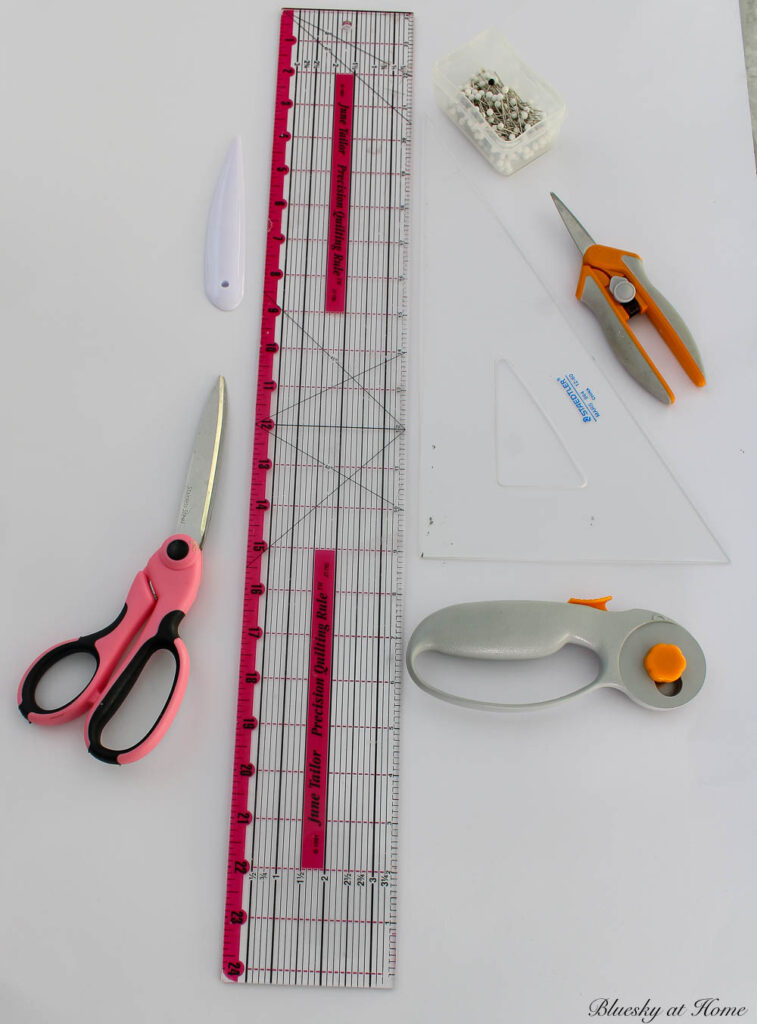
What Pillows Am I Making?
I have wanted to make these pillows for months to complete our living room accessories.
I made three different pillows:
- 3 lumbar pillows for our two swivel chairs and one Bergere chair – 20 inches X 12 inches. I bought the fabric in April at Cutting Corners in Dallas. I love the fabric (It’s a white cotton/linen with blue thread stitching in a sort of “Greek key”) pattern. It perfectly complemented the fabric we used for the Bergere chair and a new fabric ottoman. I bought 2 yards which was more than enough for the 3 pillows. I think the fabric retailed for $49.99/yard, but at Cutting Corners, it was $29/yard.

- 2 20-inch square pillows in French Blue cotton velvet. This is the fabric that we used to reupholster the Bergere chair and make the ottoman. Also from Cutting Corners. There was plenty left over for pillows and I still have plenty left over for other projects.

- 2 20-inch square pillows in white cotton/linen with the screen print in a leafy French Blue geometric pattern. I found it at the Ballard Design store not far from us. It’s called Marjorie Slate Leaf Design. I was in there with a friend browsing and fell in love with the pattern. It was $36 a yard on sale for $25 a yard. It had to be special ordered. Ballard has a 2-yard minimum on special orders which was fine since I needed 1 1/4 yards for my pillows. I will definitely use the extra.
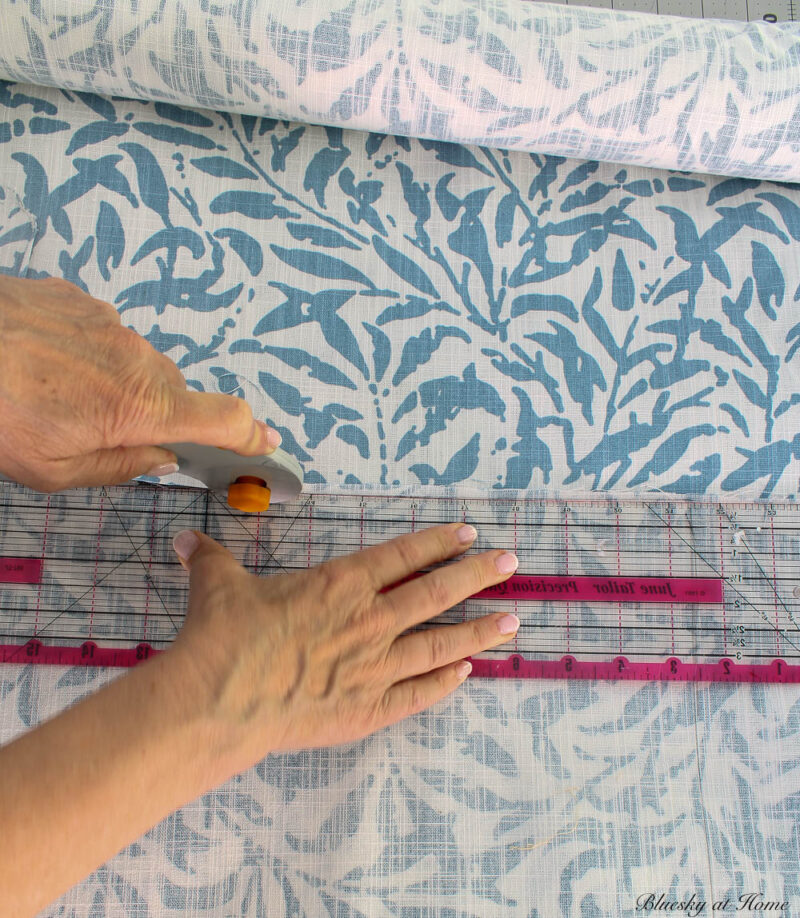
- I purchased the 4 20-inch down inserts at Ballard Design last spring and they are wonderful.
- I purchased the 3 20 X 12-inch lumbar polyester pillow inserts online. They came in a package of 4 and are great.
Making the Zippered Pillow Covers
I have used this process for making zippered pillows for many years and it has never failed me. I didn’t use any fringe or piping for these pillows, but I’ll share the one enhancement I made on the velvet pillows in a later post.
There are 3 parts to making the pillows. I’m using the 20-inch pillows for demonstrating the process. The pillow size and shape of your pillow don’t change the simple steps of the process.
I think it’s important to follow the images as well as the instructions.
Admittedly, this is a long post. I’ve tried to break down the steps into itty bitty ones to make them easier to follow. It’s really not hard and not that long.
Measuring Your Fabric
Prior to measuring and cutting, lightly iron your fabric on low heat, if necessary. Fortunately, I didn’t have to iron my fabric.
For Measuring Your Fabric:
1. Lay out your cutting mat on a large counter. I use our kitchen island.

2. Fold your fabric over, right sides together, to the measurement of your finished pillow. I folded my fabric up until I had 20 inches. Line up the selvages of the fabric together to make the fold even.
Think of the selvage as the right side of the pillow. Use straight pins to hold the fabric in place at the selvage and the fold in a lengthwise direction. Think of the fold as the bottom of the pillow. This is where the zipper will go.
3. Using your acrylic ruler, measure across the width of the fold the width of your pillow. Mine was 20 inches. Use a straight pin or pencil mark to show the measurement. Think of this as the left side of the pillow.
4. Continue measuring across the width of the fabric from the selvage to the opposite side, marking the width of the pillow as you go with a pencil. Be sure to keep the acrylic ruler straight.
4. Now place the edge of the acrylic ruler on the fabric fold. Going across the fabric, starting at the selvage, measure up the length of the pillow measurement. Use a straight pin or pencil to mark the measurement. Again, make sure that the acrylic ruler is staying straight.
5. When you reach the other side of the fabric, where you placed the first straight pin, measure across the top of the pillow measurements. Think of this line as the top of the pillow. You now have the outline of the pillow. Here you can use a 90% angle to ensure that your corners are perpendicular.
Cutting Your Fabric:
1. For this first pillow, you only have to make 2 cuts – on the fabric across from the selvage and across the top of the fabric.

2. Place the acrylic ruler with the long edge exactly on the mark you’ve made on the left side of the pillow. Pressing down firmly on the acrylic ruler and your rotary cutter, begin to cut the fabric. You may have to go back and forth over the fabric, depending on its thickness. Move the acrylic ruler and the rotary cutter as you go across the fabric.
3. Repeat on the second line, which would be the top of the pillow.
4. Lay the folded edge of the fabric flat against the counter. The straight pins are holding the fold in place. Using your small sharp scissors, cut along the fold across the width of fabric.

4. You’ve now cut out your pillow with the two right sides of the fabric together.
Sewing in the Zipper:
This step seems really long and detailed, but it is actually easy.
1. On the folded edge of your fabric, pin the two sides together with the pins pointing to the edge.

2. Two inches from the left edge of the fabric, place a pin so it goes in and out of the fabric. Repeat on the right edge of the fabric. This is to show where you will change the stitching.

3. On your sewing machine, use a regular length stitch for the first two inches and the last two inches. In between, adjust to the longest stitch. Your zipper will go between the regular switch and the long running stitch.
4. On the ironing mat, iron the zipper seam open.

5. Remove the zipper from the packaging. I only found 20 – 22-inch long zippers. You need about 16 inches of the zipper. Lay it flat and iron to remove the creases.
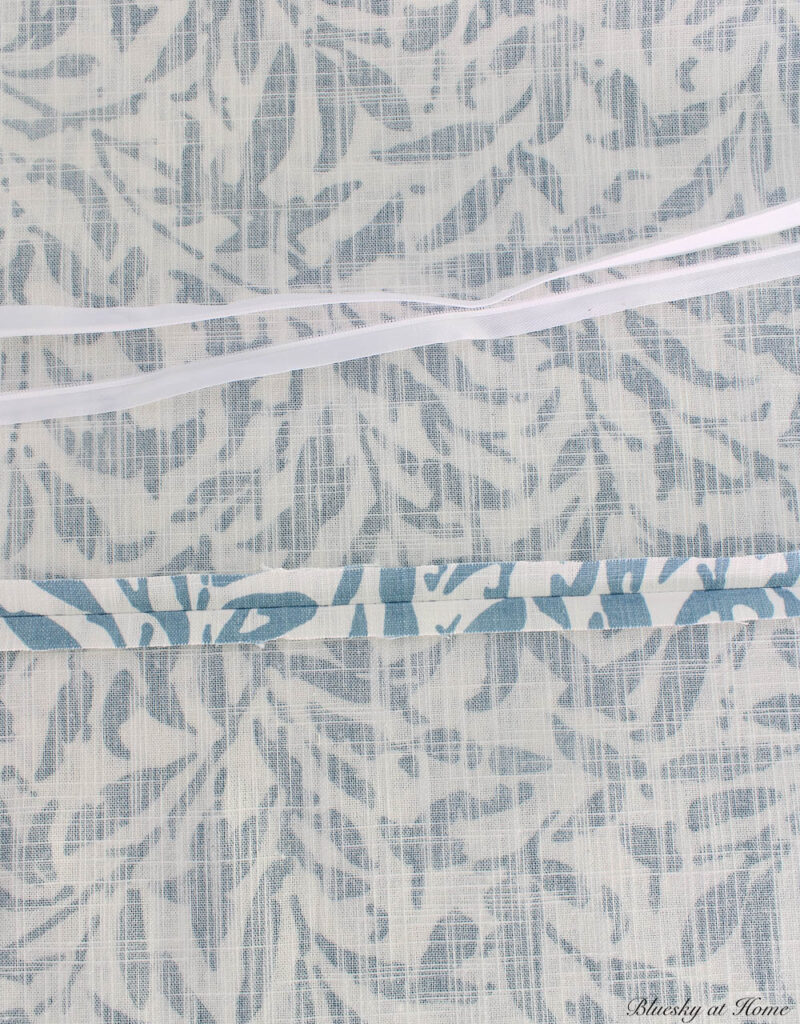
6. Lay the zipper right side down on the open seam of the pillow. Lay the fabric top of the zipper closure about 1 inch from the edge of the fabric seam. The bottom of the zipper will either go just past the stitch transition or all the way to the end of the pillow fabric (That’s what the 20 inch zipper does.)
Unzip the zipper a few inches. The zipper closure (the thing you use to open and close the zipper) should be “up” away from the zipper teeth. It’s very important that is stays exposed so you can grab it to open the zipper later. Use straight pins to pin it to the seam allowance and the face of the pillow. The teeth of the zipper should be right on the seam.
7. Use basting stitches to sew the sides of the zipper to the pillow seam. Remove the straight pins.

8. Replace the regular presser foot of your sewing machine with the zipper presser foot. Adjust the zipper foot to the right of the needle.

9. Place the zipper tape and fabric under the presser foot. Use a regular stitch length. Begin sewing the zipper to the fabric, keeping the zipper foot as close to the zipper coils as possible.

10. Where you meet the zipper closure, the zipper foot will be “forced out” a bit on the zipper fabric. It’s OK. Just move the fabric back in place as soon as possible.
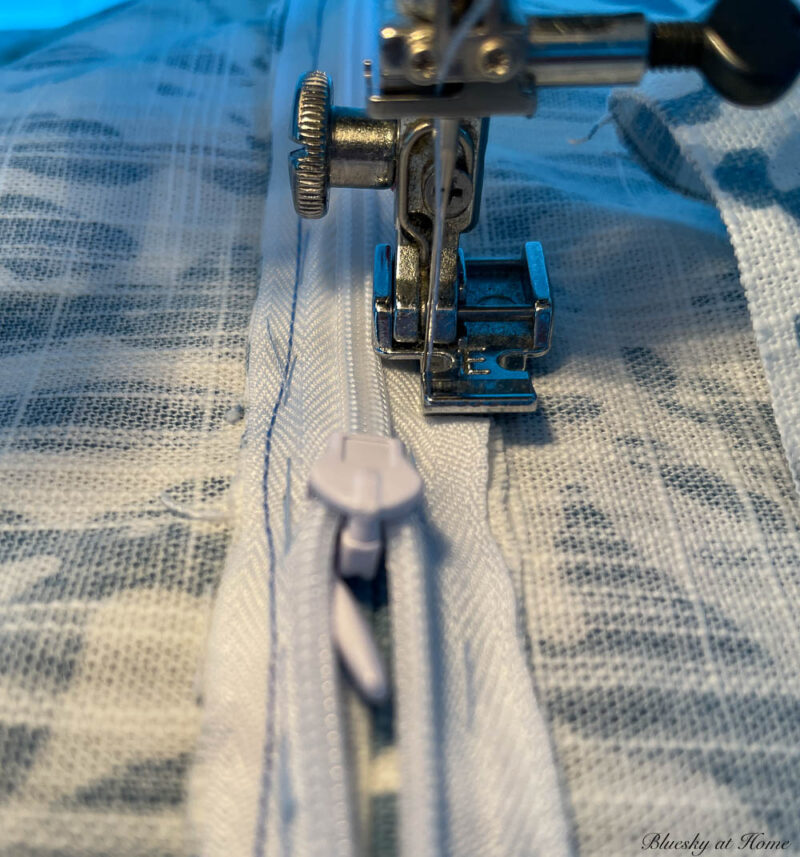
11. When you get to the end of the first side of the zipper, stop, lift the zipper foot, and turn the fabric to go across the zipper teeth.
Go very slowly. The needle will go through the zipper teeth. Cross the zipper until the zipper foot is past the zipper teeth. Lift the zipper foot, turn the fabric, and go back up the other side of the zipper until you reach the end of the zipper and the fabric. Use a back stitch to secure the stitching and cut the thread from the zipper.
Here you can see the excess zipper that you can cut off if your zipper is extra long.

12. If you have excess zipper coils, cut it off from the zipper, leaving about 1/2 inch of zipper coils/tape.
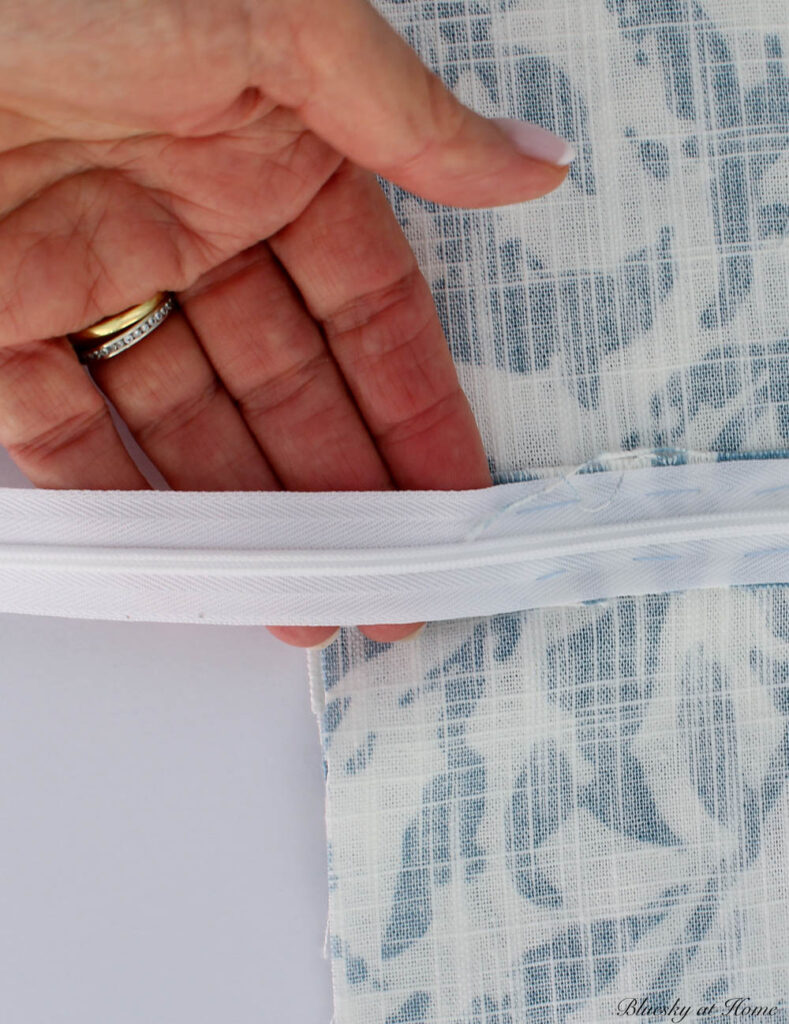
13. Replace the zipper foot with the regular foot.
14. Using a seam ripper, carefully start removing the basting stitches holding the seam closed. You will go from the top of the zipper to the bottom. As you go, you can start opening the zipper.
15. Remove the basting stitches that held the zipper to the fabric.
Sewing the Pillow:
This is the easy part. I use a 1/2 inch seam allowance on my pillows.
1. With the right sides of the fabric together and starting at the four corners, pin the three remaining sides of the pillow together with straight pins. Be sure to keep the raw edges of the fabric even and smooth.
2. Return to your sewing machine. Place the pillow in the sewing machine near one edge at the top of the zipper. The zipper must be mostly open.
3. Stitch the pillow from one side to the other. Backstitch at the beginning and the end of the stitching. When you get about 1 inch from the corners, increase the seam allowance to 5/8 inch. Then go back to 1/2 inch on the other side of the corner. This little trick keeps you from having points on the corners of your pillows.
4. Cut off the corners of the pillow seam allowance on the diagonal. This keeps your pillow corners from being bulky.
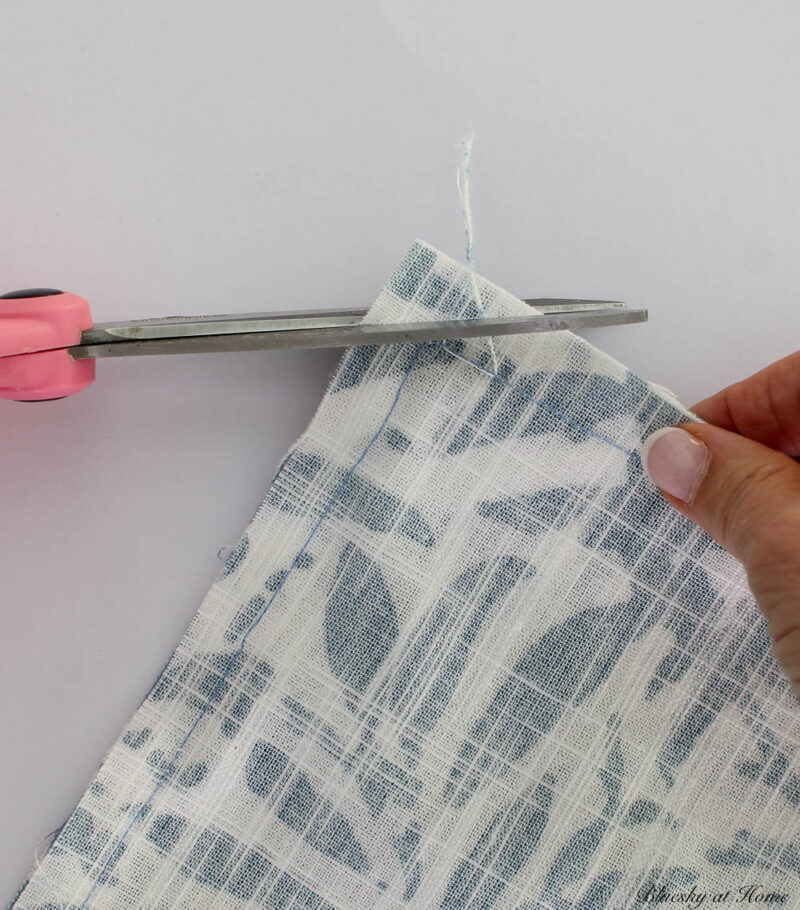
5. With the zipper completely open, turn the pillow right side out.
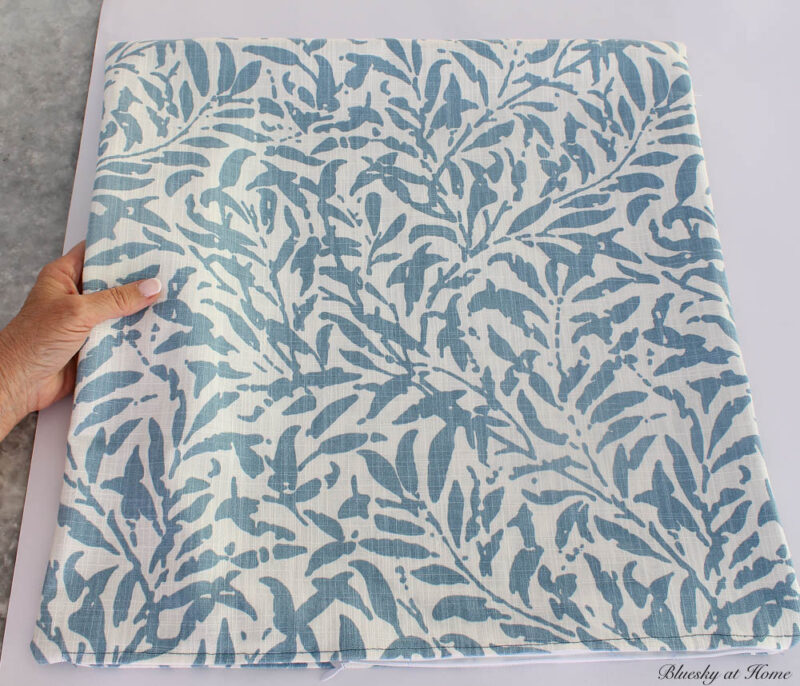
6. Use your fingernail or a plastic collar turner to push out the inside seam of the corners of the pillows.

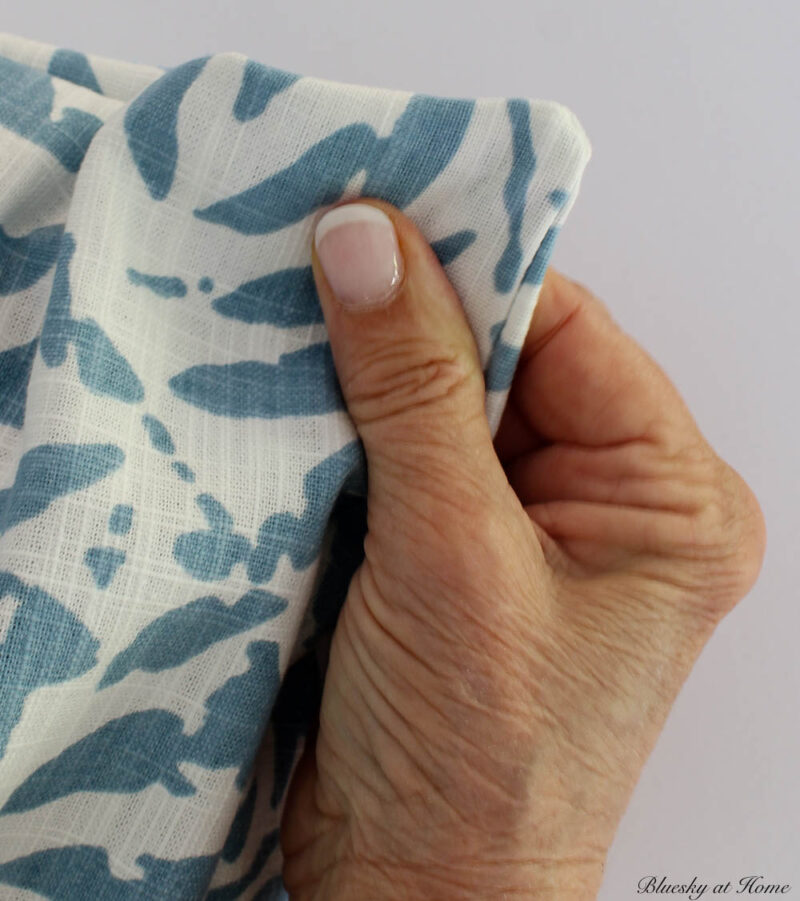
Inserting the Pillow Insert:
1. The easiest way to do this is to sit in a chair. Fold the pillow insert in half and push into the pillow cover, all the way to the back of the pillow.
2. Open the pillow insert and push it flat in the pillow cover filling the sides. Push it back into the corners of the pillow.
3. Place the pillow between your legs and squeeze, closing the zipper until the insert is fully inside the pillow cover.
4. Give your pillow a few good whacks on a hard surface. This helps to distribute the pillow insert evenly in the pillow cover.
Display Your Pillow and Enjoy
Now it’s time to show off your pretty pillows.
The lumbar pillows make the chairs even more comfortable. Don’t you love the pop of blue?

In the background, you can see the custom ottoman we had made. It is the same fabric as the chair, but the light makes it look totally different.
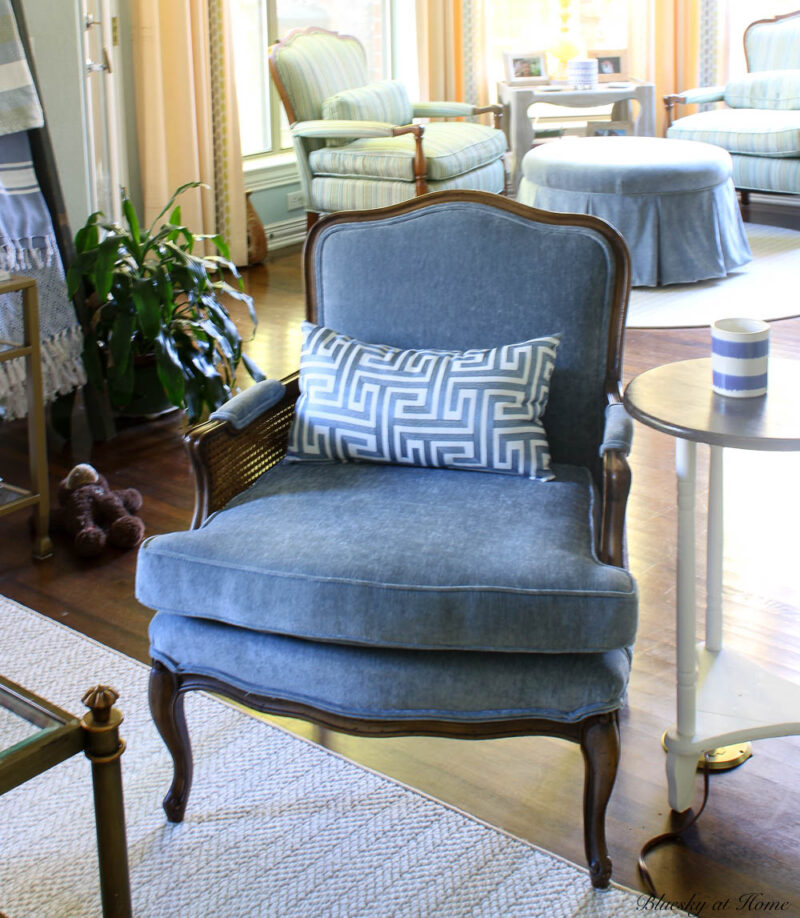

I love how the velvet pillows and the patterned pillows work together. Here is how to make and add trim to a pillow.


I hope you now feel comfortable making your own custom pillow covers with zippers. Once you try a couple, you’ll be a pro.
Making zippered pillow covers really is one of the most satisfying and cost-effective projects. You get exactly the pillows you want.
I highly encourage you to PIN this post so you always have the tutorial handy.
Now take a look at the next project on our Creative Craft Blog Hop. Cecilia of My Thrift Store Addiction is up next.
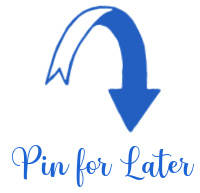



Embellish Pumpkin with Flower Molds
5 Easy Steps for Making a Milkweed Pod Wreath
Autumn Sunflower Free Printable Decor
How To Make A DIY Fairy Garden House From A Coffee Mug

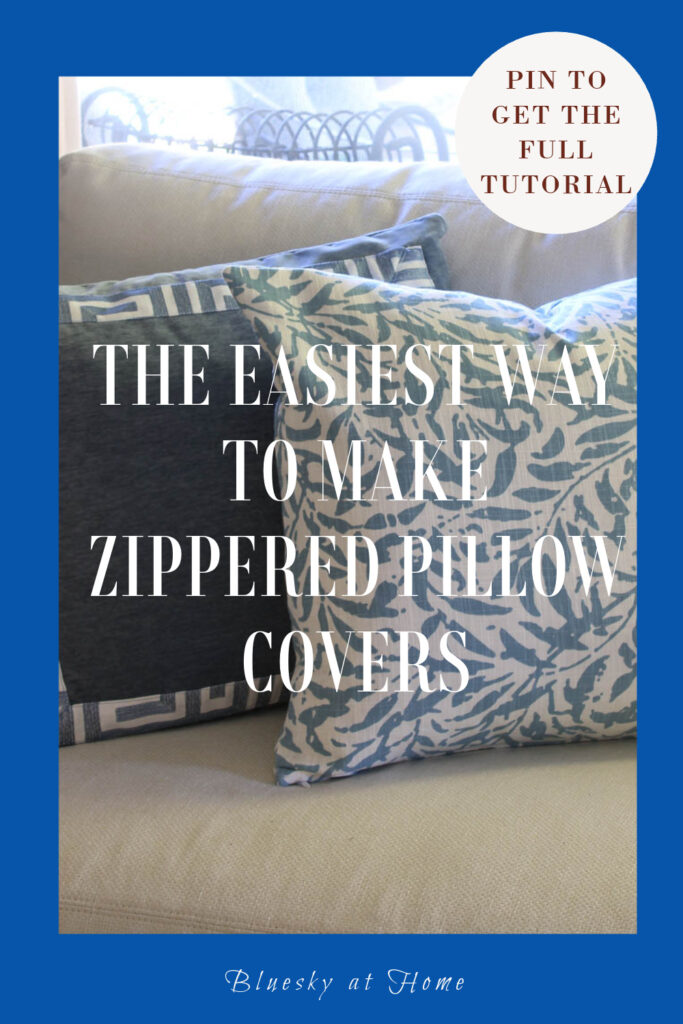


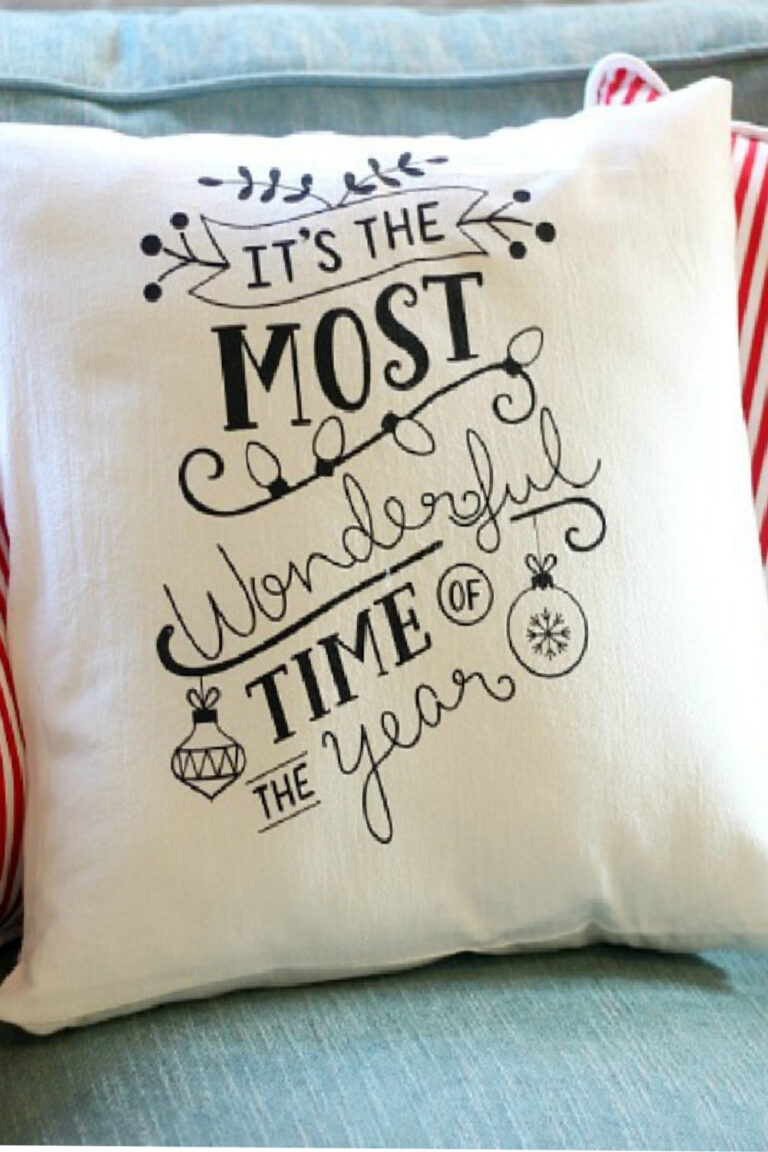

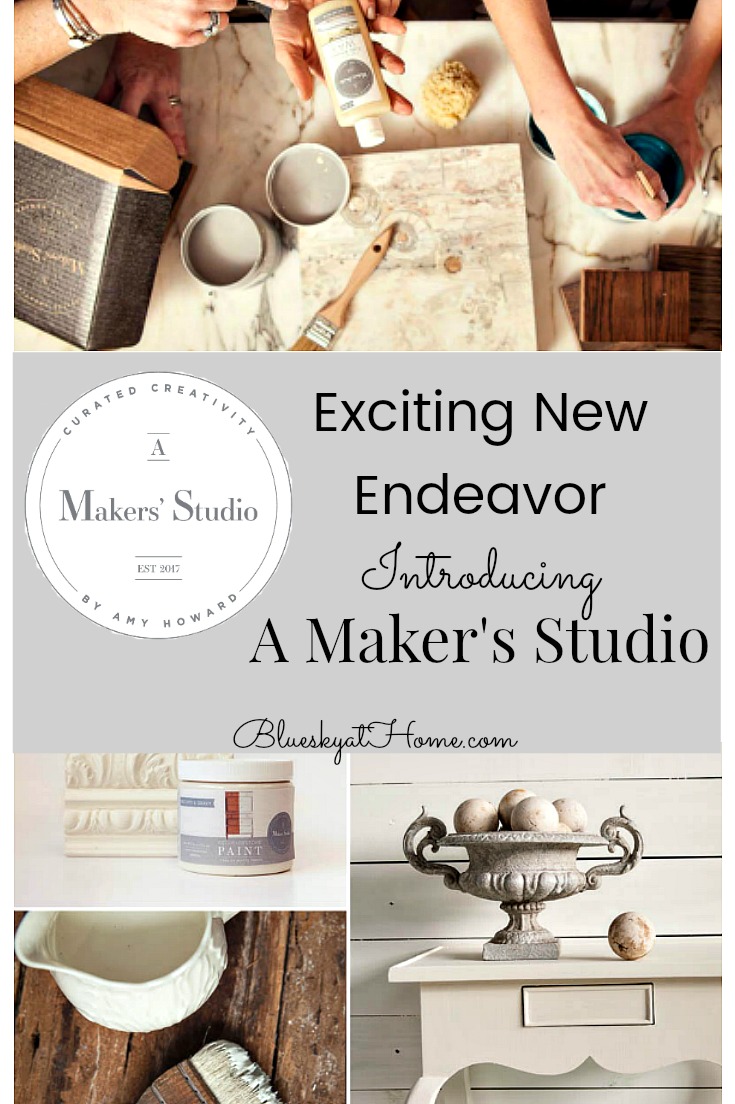

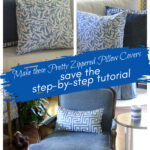

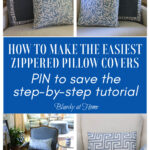
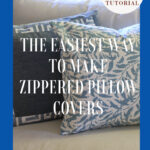

I am following you on Pinterest and Facebook.
I read “The Easiest Way to Make Zippered Pillow Covers”, pinned the article, but cannot figure out how to get the full PDF Tutorial.
What lovely fabric and a great pillow cover tutorial, Carol!
I love how your pillow look with your pretty new furniture Carol! Excellent tutorial too!
This is such a timely tutorial for me! I’m doing a video & blog post on Monday about decorating with fall pillows, & I have fabric to make a few. I haven’t sewn in a zipper EVER yet, so this will be helpful. It’s always great hopping with you to see the beautiful & creative decor ideas you come up with! Pinned!
Oh, I’m so glad! I know it’s a long post, but just take the steps one at a time and you’ll be fine. Would love to see the finished pillows.
Your pillows look wonderful! Even though they were a DIY, yours look luxurious and just like those expensive custom-made ones. You’re a pro!
Thank you Allison. I swooned over them then I walked into our living room this morning. What a difference they make. They would have cost a small fortune to have them made. DIy is the only way to go!
Your pillows are quite lovely, Carol! They certainly look high end! I love that your tutorial goes into great detail! It covers everything we need to know about making zippered pillow covers! Thanks for sharing!
As a master crafter, Gail, this project should be right up your alley.
I love to decorate with pillows, and have a closet full! You are so smart to make your own pillow covers, what a space saver! Your tutorial is very thorough and professional Carol~ thank you and happy sewing!
Hey, Jenna. We all love our pillows. For those of us who want the high-end look, but not the price, making them ourselves is the only option.
Great tutorial Carol. I make a lot of my own pillow covers too and it is so rewarding to have custom pillows that match the drapery or your seasonal decor. Your pillows turned out beautifully! Great job.
Thank you, Tammy. I love that you appreciate the value of making your own pillows. I do love using complementary fabrics. It really makes for a custom look.